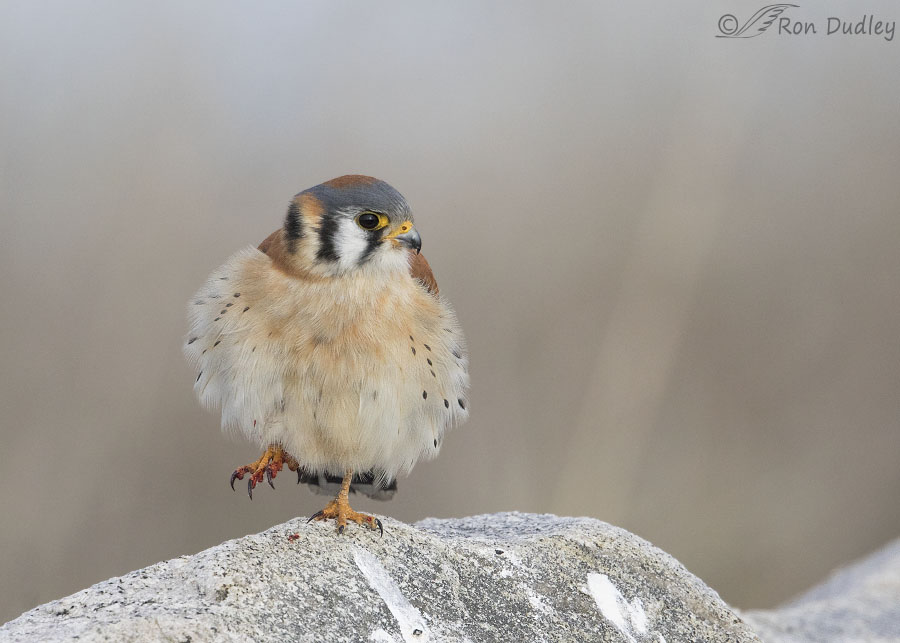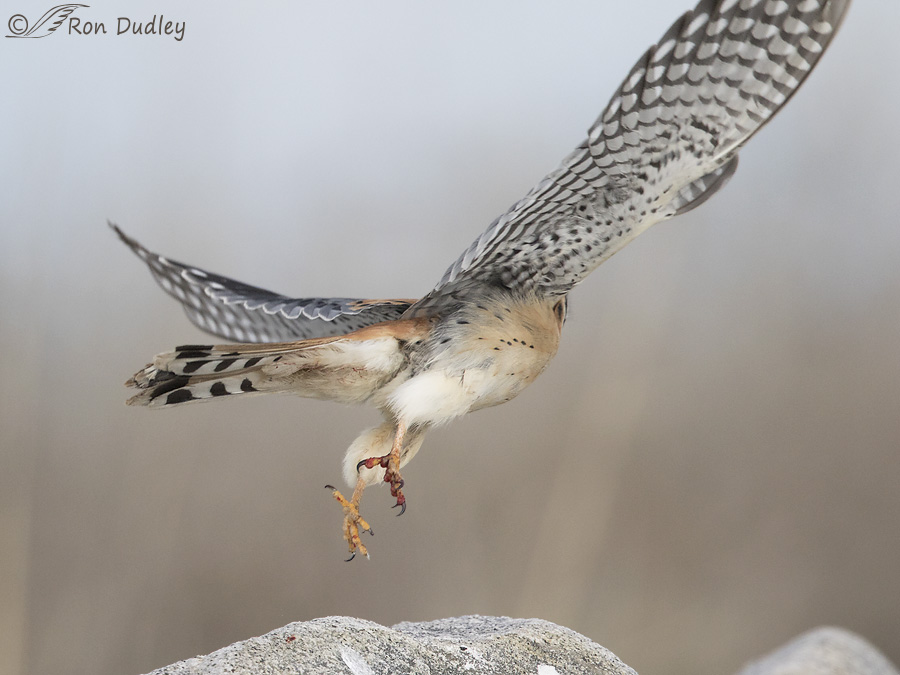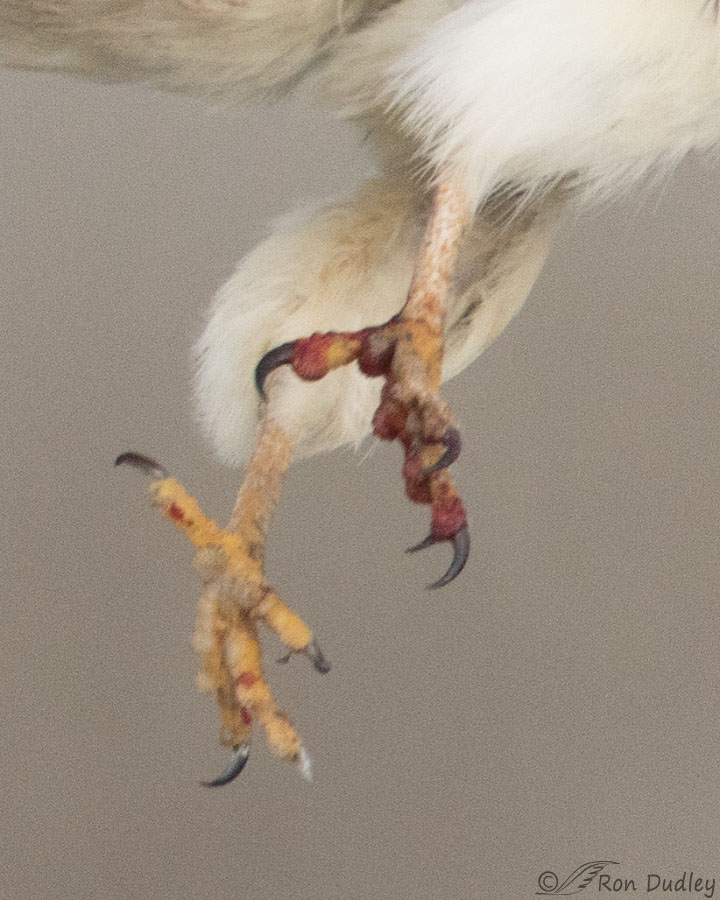I’ve had a change of heart about the likely cause of his unusual behavior.

1/4000, f/5.6, ISO 800, Canon 7D Mark II, Canon EF 500mm f/4L IS II USM + EF 1.4 III Extender, not baited, set up or called in
I noticed his quirky behavior while photographing him just over a year ago at Farmington Bay WMA. He was perched on this rock for several minutes and during the entire time he never put his right foot down. Instead he always held it off the rock like this or tucked it into his belly feathers as kestrels often do when they’re relaxed and resting. At one point he flew off after prey (which he missed) and then returned to the rock but once again he kept his foot raised the entire time except for a brief moment when he turned on the perch to take off. On one occasion he picked at that foot with his beak but only for a few seconds before returning to this unusual foot-off-the-rock pose.
That right foot is quite bloody and there’s even a spot of blood on the rock but when I posted other photos of this bird last year (this one is new to my blog) it was my assumption that the source of the blood was a recent meal (most likely a vole). At the time I considered the possibility that the foot was injured but rejected it for a variety of reasons (other than the raised foot his behavior seemed normal and I didn’t think birds would bleed this much from an injured foot since circulation in their feet is somewhat reduced as a heat-saving device).

When he flew off it revealed just how much blood there was on that foot. There’s even some blood on his left foot and it seemed more likely to me that so much blood would more likely come from prey as he was eating than it would from a typical injury.

I wondered if a much closer look at his feet might reveal an injury visually so last night I cropped tightly on them but except for all the blood his feet and toe pads look normal to my untrained eye so I was still leaning in the direction of prey being the source of the blood rather than an injury.
But the more I think about it the less sure I become. It seems to me that blood from prey on his feet wouldn’t prevent him from standing on that foot – especially for such an extended period of time. So last night I went back and re-read comments on my post from last year and noticed what Louise Shimmel said:
- “My guess is that the foot is injured. If it’s not weight bearing, the leg could be injured anywhere from the femur on down, but the blood to me speaks of a foot injury. We get birds in with obvious prey bites on their feet (that can lead to really bad infections), which is why one of the first things a young raptor needs to learn is where to grab hold of prey and how to administer the coup de grace to the back of the head. And foot injuries can bleed plenty, I promise you.”
Louise is a very experienced rehabber and I trust her judgment implicitly so all things considered I now believe that an injury was the most likely source of the blood and that injury was probably a bite from prey. Rodent teeth can be wicked.
It took me a year to arrive at that conclusion so I’m slow but I’m also persistent…
Ron


What an interesting thread! I’m so glad you posted this follow up and the astute observations about what might have happened. A predator bite wouldn’t have been what I would have considered first. Thanks for the education. I so hope this kestrel healed fully.
The toe pads look swollen too.
I hope his foot healed properly. I have a parrot and a couple of times I clipped too much off her talons. A lot of blood would drip from that wound. I have a styptic powder I can put on the wound to stop the bleeding. She will stand just like this kestrel until the next day. I now use a file to trim her talons,
Debbie, I remember clipping one of my dog’s toenails too close once. I didn’t do it again…
Louise says it, it is correct. Hope he recovers but they have to be perfect to survive;. And of course he will not show he is hurt. Any raptor that shows injuries will soon become prey. That is why I had such trouble trying to capture injured raptors. They go to ground.
Interesting point, Diana.
As falconers, we have to be hyper-sensitive to any changes in our bird’s (birds’) behavior just for that reason. Since they do not show any kind of weakness until about 30 seconds before they’re going to die, even the slightest change must be investigated and dealt with NOW, not tomorrow! Waiting to see what happens is not an option!
Poor baby! I often wonder about your subjects and what happens to them down the line. I wish there was a way to fast-forward to find out, but alas, there’s no last page of the book to skip to (yes, I love reading mystery and crime novels, but have to find out how they end or I get too anxious!). I’d love to meet Louise some day.
I’d enjoy meeting her too, Marty. She’s a wealth of knowledge and she really cares about birds and all things natural (I follow her and Cascades Raptor Center on Facebook which gives me some insight on that).
You’d love her Ron! She’s an outstanding human being! Simply outstanding, like you
Yup, I agree that if Louise says it, she’s bang on I got to work with her and she is a walking
I got to work with her and she is a walking
encyclopedia of all things bird!
The left foot is a bit blurry but wonder if those could be pox lesions on that foot
and the right foot looks to have spots of inflammation and as I recall, pox lesions can
be quite bloody messes when the lesions break open.
I dunno, Karen. Out of my field of semi-expertise…
Karen, you’re probably right. I didn’t think about that and the little pads (I’m sure Louise would know the REAL word for those…LOL!) look swollen!
I’m envious that you got to work with Louise. She ROCKS! I got to take the basic skills course from her, plus she used to be on one of the hawk lists when I first started falconry/rehab/education programs. She’s a dynamo on a bunch of different levels!
I’m with Louise 100%. That much blood is not unusual from prey EXCEPT that the pool of blood on the rock indicates an injury. In other words, he’s actively bleeding and that’s NOT usual from just handling (footing) his prey. Add in that he’s unwilling to put weight on that foot and there you have it.
Plus, Louise knows her stuff! I don’t think there’s enough money in the world to make me disagree with her unless it’s something like sports car racing. She doesn’t know much about that…HEHEHE! But bird stuff–NOPE! Not going there! I’ve learned SO much from her over the years!
So have I, Laura. I’ve learned to trust her judgment implicitly.
I might be Louise’s biggest fan, although I dare say anyone who spends a little time with her joins that club, too! I can say I knew her when her Center was little more than a dream–one that she made come true. Don’t nobody better disrespect her around me (NASCAR language…Daytona is coming…LOL!). They’ll live to regret it!
Interesting Ron. I can only imagine how hard it is for a raptor to function with a damaged talon. I had not thought of this before, that when they attack prey their talons are at risk from a bite from their prey. (I once saw a N. Harrier operating with one leg though, survival…
Ed, on several occasions I’ve seen raptors being bitten by voles and then dropping them in flight. From the reaction of the bird that’s obviously what happened. Those rodent teeth can be extremely effective defensively.
At least twice I’ve seen coyotes being bitten on the tongue/mouth by voles. The reactions of the coyotes were hilarious.
What an experience, to be picked up by a big bird, then bite their talon and float back to the ground. Can you imagine the bar stories the voles tell after such an experience!
BTW the lighting on your first image is awesome! It has a beautiful soft light of winter to it. I miss winter…perhaps soon I will be able to drive your way and then up to the Tetons for some winter photography. All we have is brown dust at this point, my bees are flying, trees are budding, with no snow in sight.
It’s also available for talons to break, much like when our fingernails break into the quick. Raptors don’t live safe lives.
Poor guy! Looks like an injury to me, too….blood may or may not be his, but foot lifting sction indicates injury…)great close up of those fluffy britches.)..
Thank you, Patty.
On review, foot looks discolored and swollen…hope it isn’t infected and bird heals Ok…so many young raptors don’t…
It seems likely that the kestrel was bitten by the vole; I did a little wildlife rehab, and that’s how it looks from here. . .
That’s the direction I lean, Martha.
Super shots Ron. I certainly hope he recovers.
Charlotte
Hopefully he did, Charlotte.
The Kestrel is certainly beautiful. Given the injury and the resting of the foot, I wonder how he managed getting his next prey and holding on to it for the kill… He certainly put up a ‘brave front’ but then to show weakness would make him a more accessible target. The more I observe nature in progress, the more I am in awe.
Kathy, I keep wondering how he fared over the long haul. I hope he’s still out there somewhere…
Very interesting and I agree with your guests. Makes sense that it is a foot injury creating all the blood on the foot.
Thanks for the post.
Thank you, Dick.
This photo is both beautiful & sad. Do you know if predatory birds learn from watching their parents “in action”? Most likely the skill is passed on via their DNA? If not, then trial & error and nature’s way of teaching tests all living creatures the value of endurance & pain.
“Do you know if predatory birds learn from watching their parents “in action”?”
To say I “know” that is probably too strong, Elmer, but in observing fledgling raptors at or near the nest I’m quite sure that they do.
Not a bird rehabber but a physician and this looks like acute injury blood. At least human blood dries quickly and turns dark while this looks bright red which means to me that it is still oozing from an injury. The fact that it is in several places seems like it would be consistent with several teeth bites. Not wanting to put weight on it would be consistent with discomfort and injury. In pediatrics we call this a booboo.
Good point, John. Loved your last sentence!
I would agree with the injury theory given it not putting weight on the foot besides being bloody. Since “critters” tend to try and hide injuries this must have been quite painful. Hopefully it recovered! Always something to learn/reassess!
Judy, In reviewing some of my images I noticed that he did put his foot down on the rock once but that was only when he turned on the perch in preparation for taking off of after prey. I still think it was injured.